Jeju dining offers glimpse into ‘haenyeo’ life
Stories of Jeju’s Bukchon unfolds through haenyeo chef’s dishes at Haenyeo’s Kitchen
By Kim Hae-yeonPublished : June 4, 2022 - 16:01
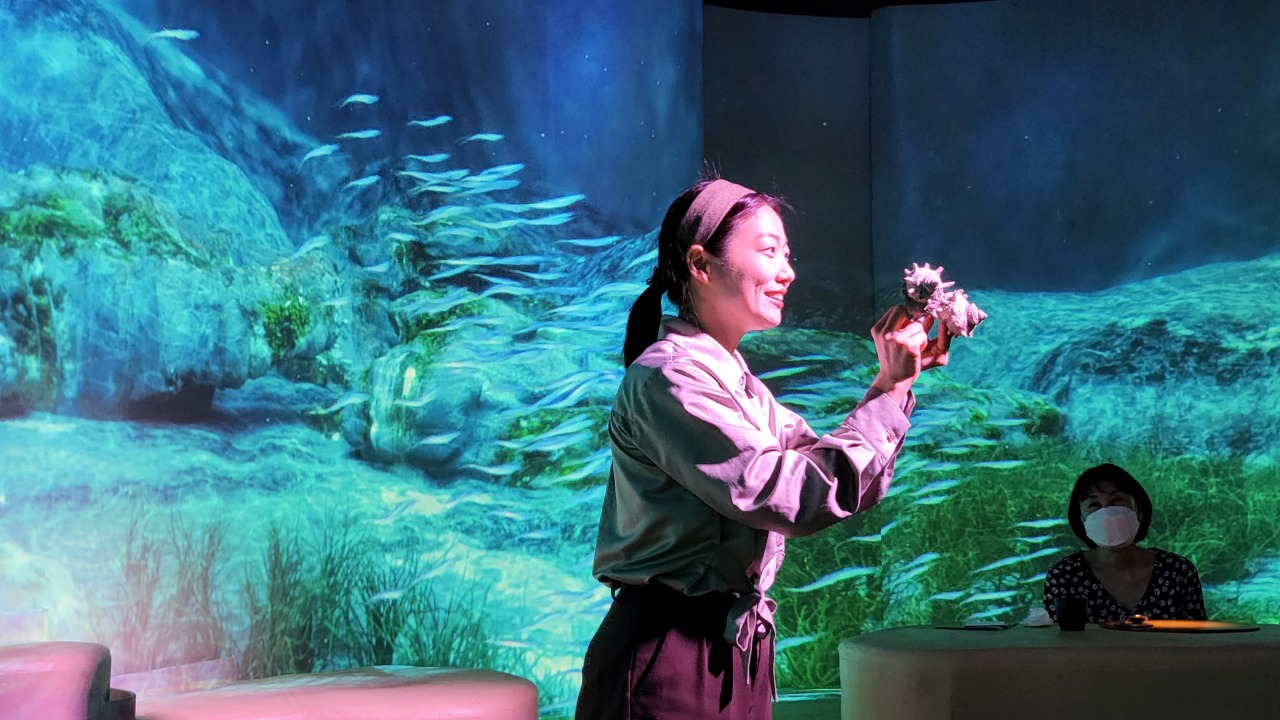
JEJU ISLAND -- In the quiet coastal village of Bukchon-ri, east of Jeju, home of hundreds of victims brutally massacred during the April 3 Jeju Uprising is a colorfully painted warehouse.
Unlike other fishing villages in Jeju that entice visitors with lively fish markets and seafood eateries, this neighborhood does not have tourist attractions in sight, making its surrounding even more serene.
A greeting at the entrance by a staffer wearing a modified diving suit usually worn by Jeju women divers signals the start of a unique dining experience at Haenyeo’s Kitchen where a dark and foggy hall of the colorful warehouse promises something out of the ordinary.
Two installation artworks on the lives of “haenyeo” are on display and a 1975 documentary on a 12-year-old haenyeo, narrated in English, plays on a large screen inside the first hall.
After a 10-minute explanation by a curator, the guests are led to the second hall, the main dining area. Almost everything in the dining hall is made with upcycled materials from haenyeo working gear.
“You will notice a sign put up at the entrance, which is about haenyeo culture designated a UNESCO World Heritage,” the chief manager at Haenyeo’s Kitchen in Bukchon told The Korea Herald.
There is a saying in Jeju these days that the haenyeo culture will completely disappear in the next 15 years, according to the manager.
Unlike other fishing villages in Jeju that entice visitors with lively fish markets and seafood eateries, this neighborhood does not have tourist attractions in sight, making its surrounding even more serene.
A greeting at the entrance by a staffer wearing a modified diving suit usually worn by Jeju women divers signals the start of a unique dining experience at Haenyeo’s Kitchen where a dark and foggy hall of the colorful warehouse promises something out of the ordinary.
Two installation artworks on the lives of “haenyeo” are on display and a 1975 documentary on a 12-year-old haenyeo, narrated in English, plays on a large screen inside the first hall.
After a 10-minute explanation by a curator, the guests are led to the second hall, the main dining area. Almost everything in the dining hall is made with upcycled materials from haenyeo working gear.
“You will notice a sign put up at the entrance, which is about haenyeo culture designated a UNESCO World Heritage,” the chief manager at Haenyeo’s Kitchen in Bukchon told The Korea Herald.
There is a saying in Jeju these days that the haenyeo culture will completely disappear in the next 15 years, according to the manager.
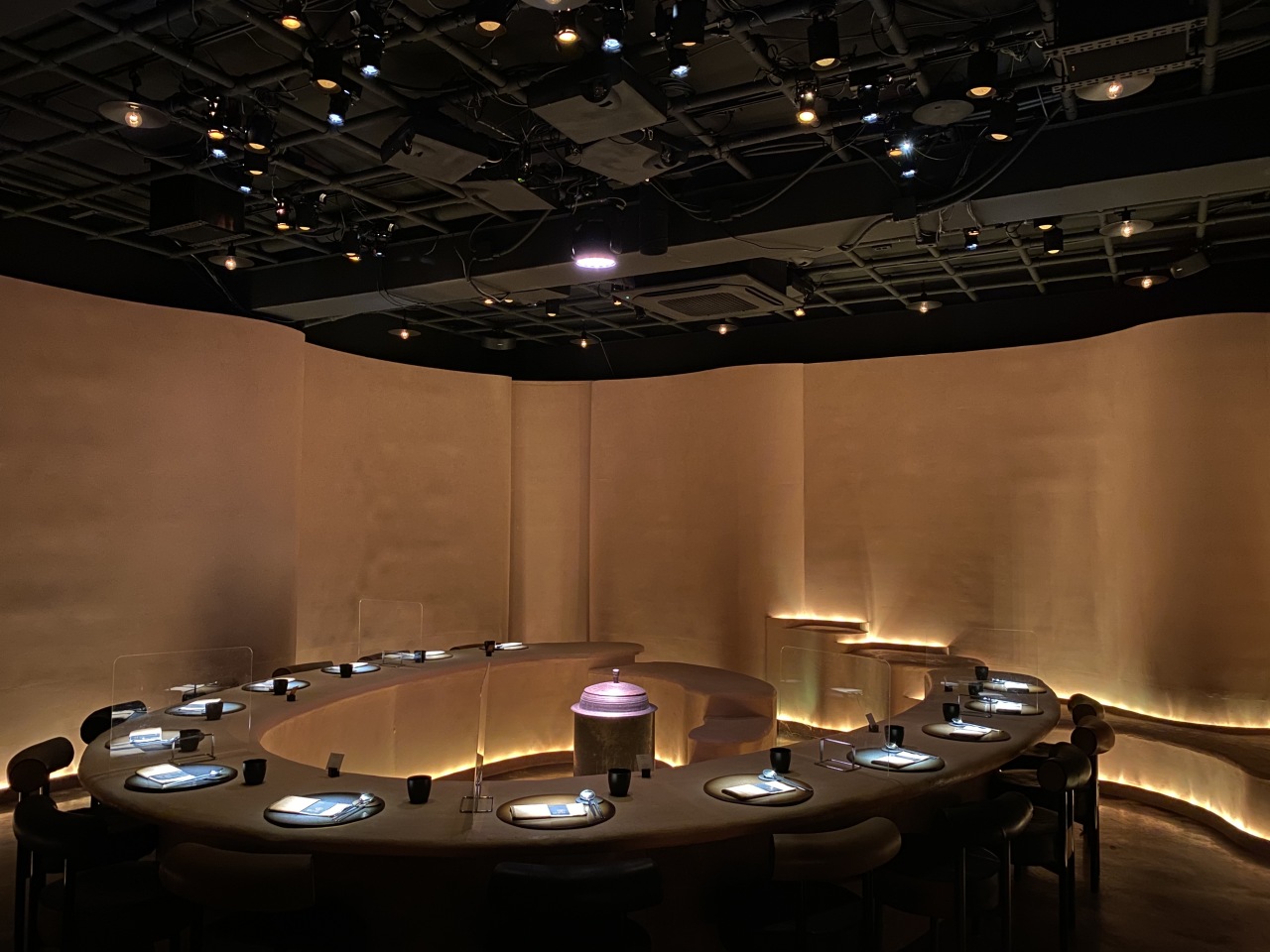
“While our staff take pride in serving guests with our creative menus based on fresh ingredients available at Bukchon, we also hope our visitors can keep the conversation going about this village and the haenyeo culture, long after leaving the place.”
After the end of an hourlong docent-led dining trip, the main haenyeo chef takes questions from guests on women divers.
Below are four dishes that are offered at lunch time. The menu may change seasonally. Those who prefer fish to meat can request a change when making reservations.
After the end of an hourlong docent-led dining trip, the main haenyeo chef takes questions from guests on women divers.
Below are four dishes that are offered at lunch time. The menu may change seasonally. Those who prefer fish to meat can request a change when making reservations.
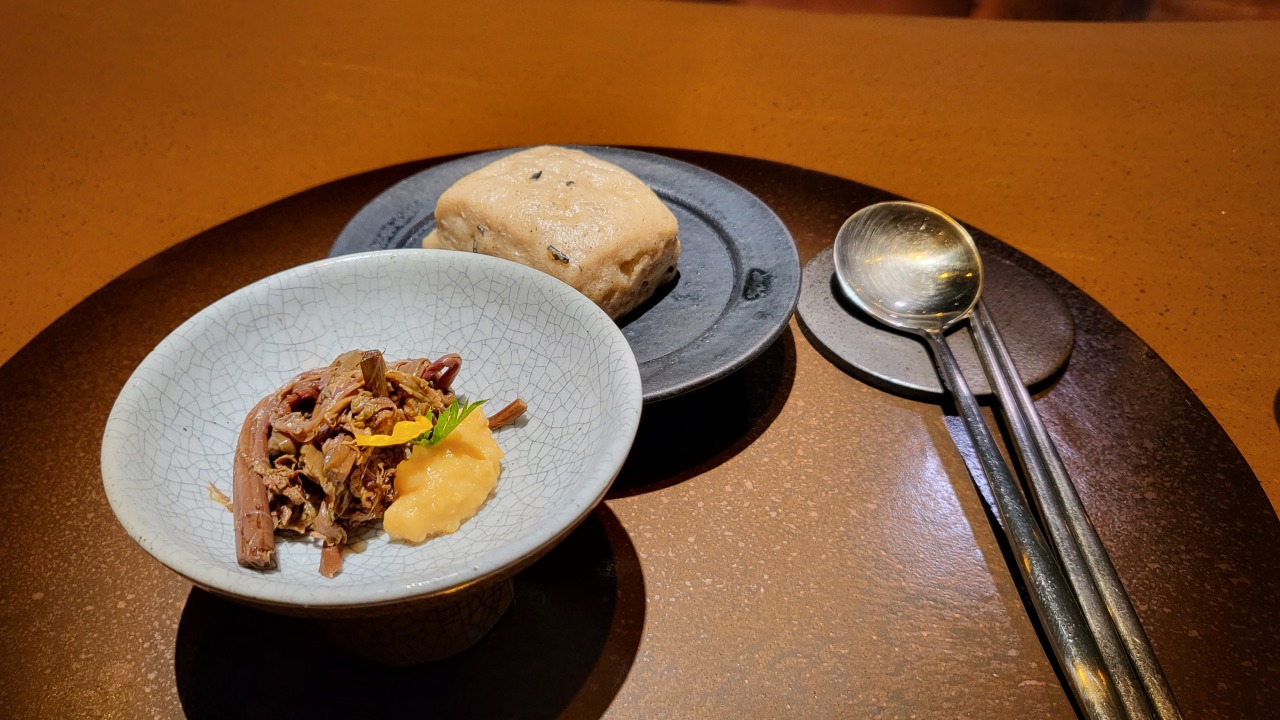
(1) Seasoned Jeju fern paired with Jeju sangwaetteok
Sangwaetteok is made of barley instead of the usual rice, since rice is not grown on the island, and fermented with makgeolli. It is taken with a bit of cooked fern and a dollop of doenjang made with special Jeju-cultivated beans that, together, create a moist and savory mouthful.
Sangwaetteok is made of barley instead of the usual rice, since rice is not grown on the island, and fermented with makgeolli. It is taken with a bit of cooked fern and a dollop of doenjang made with special Jeju-cultivated beans that, together, create a moist and savory mouthful.
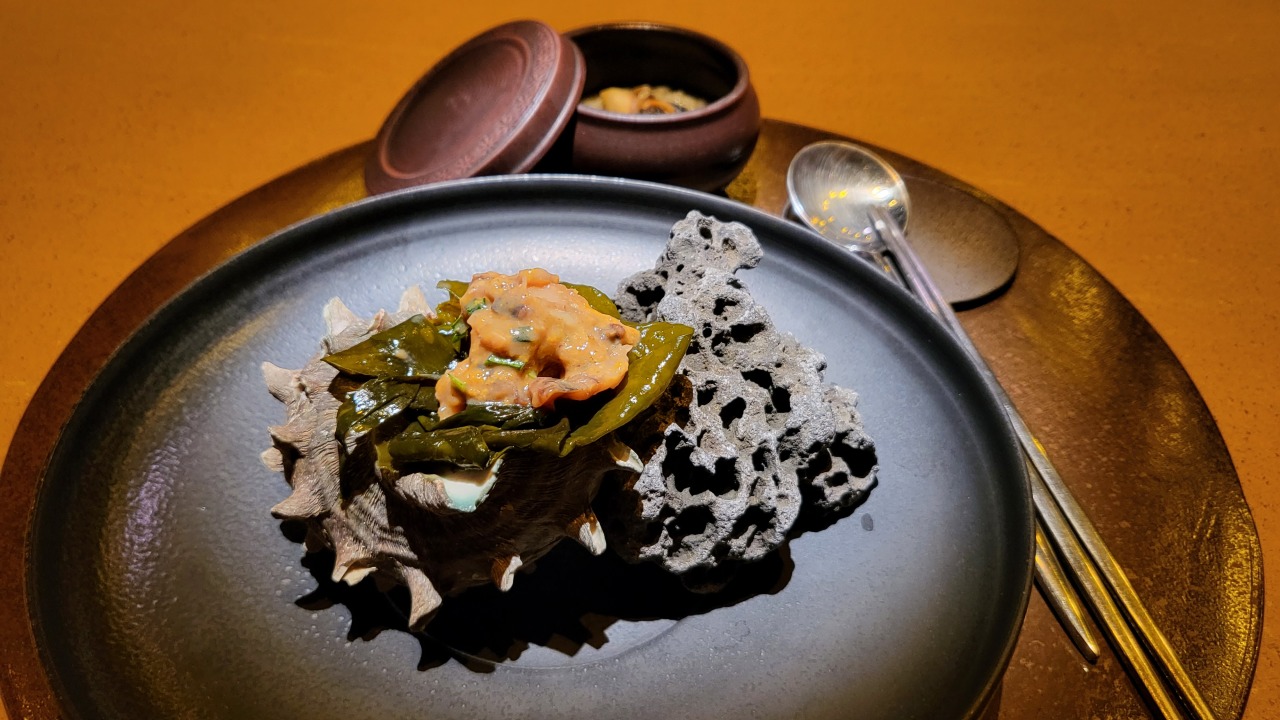
(2) Ppulsora salad and ppulsora porridge
On Jeju Island, a type of fresh seaweed, dolmiyeok, is used as a wrap to make ssam with slices of ppulsora, a type of marine snail, and sea urchin roe, inside.
A ppulsora porridge with sliced snail intestines stir-fried in sesame oil is offered on the side. The porridge is commonly eaten by haenyeo before and after going out to sea, according to the guide.
On Jeju Island, a type of fresh seaweed, dolmiyeok, is used as a wrap to make ssam with slices of ppulsora, a type of marine snail, and sea urchin roe, inside.
A ppulsora porridge with sliced snail intestines stir-fried in sesame oil is offered on the side. The porridge is commonly eaten by haenyeo before and after going out to sea, according to the guide.
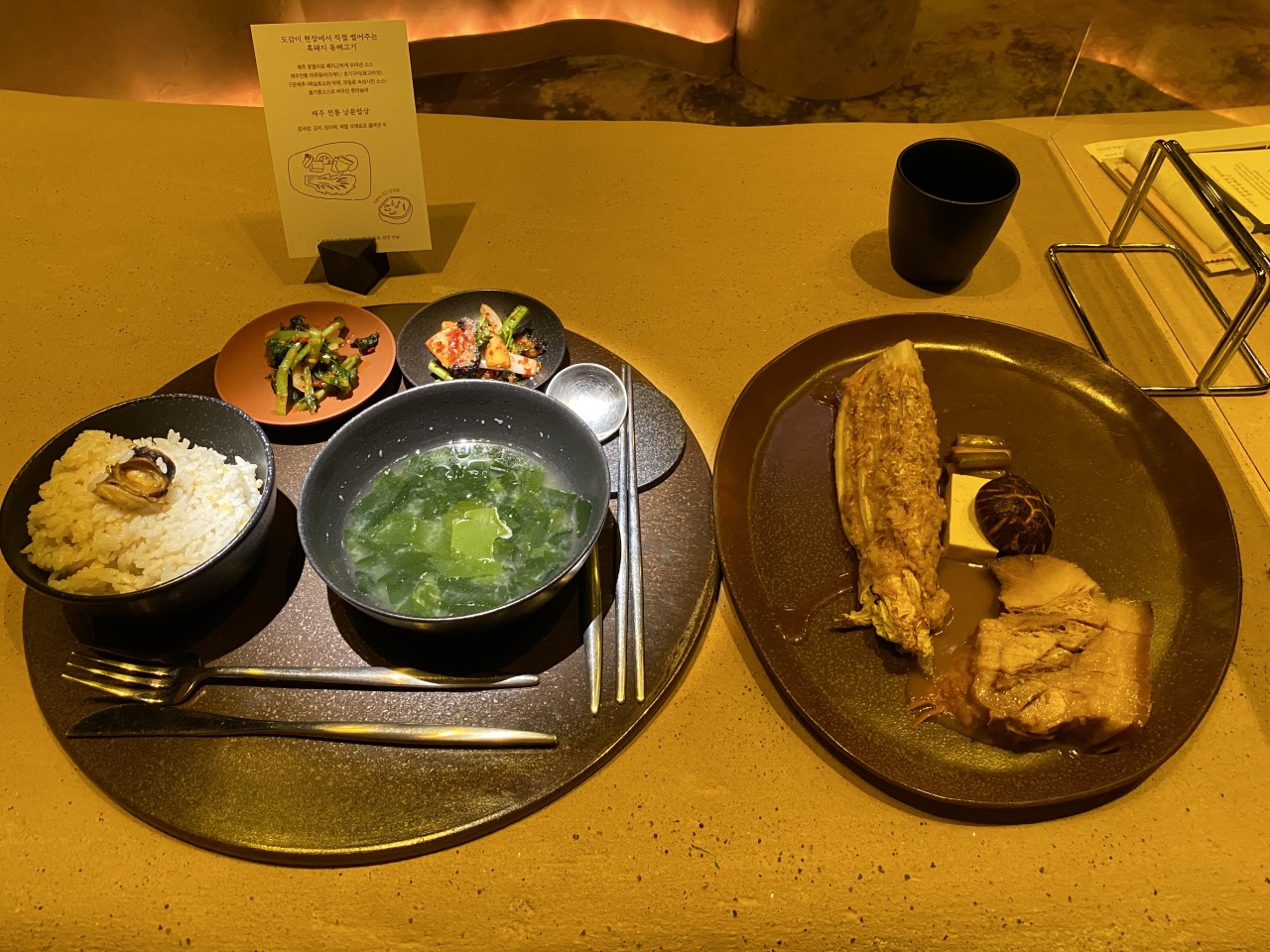
(3) Dombaegogi, boiled black pork slices with grilled cabbage
The kitchen’s main dish, dombaegogi, boiled black pork slices, is a typical Jeju delicacy enjoyed on festive days.
Domabegogi is served with an assortment of side dishes -- silver-stripe round herring gravy, traditional Jeju-style dried tofu, grilled Jeju shiitake mushrooms and grilled cabbage.
The unique sauce spread on top of the cabbage is made from various vegetables and fruits, including fermented green plum juice seasoned with perilla oil.
A bowl of multigrain rice, seasoned gunso, a type of marine snail, and doenjang seaweed soup are served with the pork slices.
The kitchen’s main dish, dombaegogi, boiled black pork slices, is a typical Jeju delicacy enjoyed on festive days.
Domabegogi is served with an assortment of side dishes -- silver-stripe round herring gravy, traditional Jeju-style dried tofu, grilled Jeju shiitake mushrooms and grilled cabbage.
The unique sauce spread on top of the cabbage is made from various vegetables and fruits, including fermented green plum juice seasoned with perilla oil.
A bowl of multigrain rice, seasoned gunso, a type of marine snail, and doenjang seaweed soup are served with the pork slices.
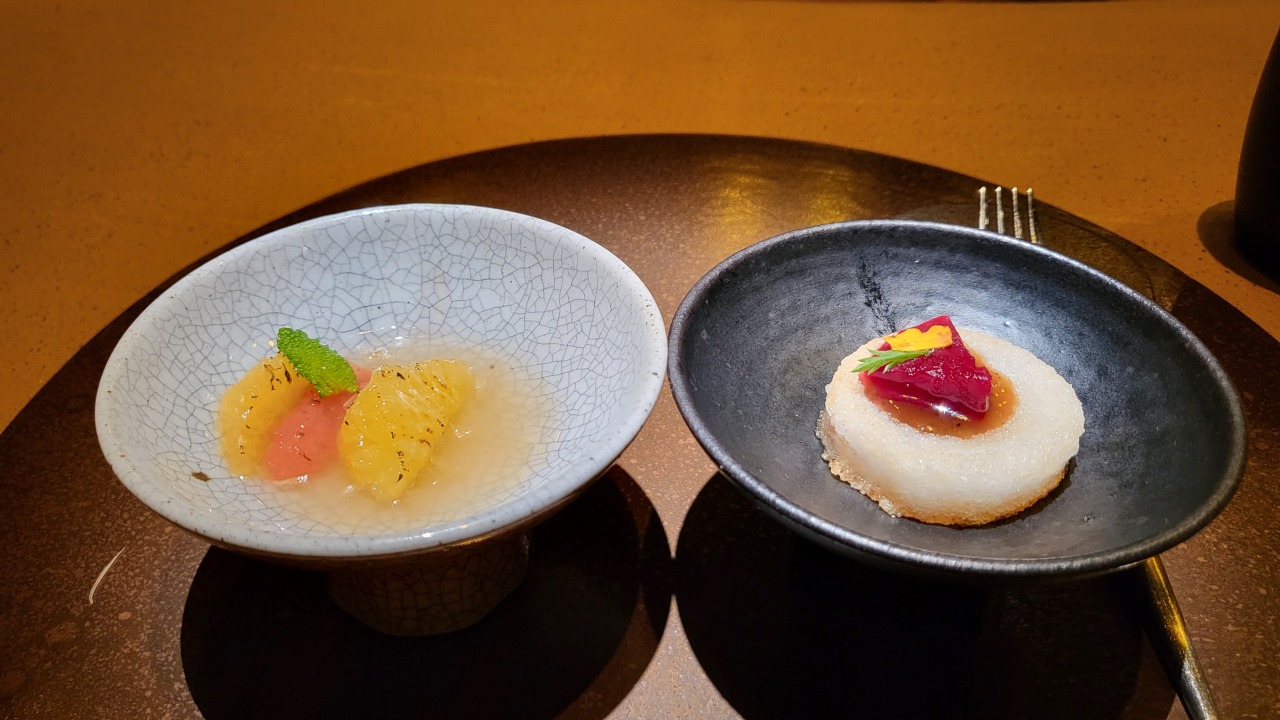
(4) Jireumtteok topped with red sea cucumber yeot and seasonal fruits
Red sea cucumber yeot is drizzled on top of white jireum tteok, a Jeju-style deep-fried tteok.
Simmered and reduced for 12 hours, the red sea cucumber yeot has traditionally been served as a reenergizing treat for haenyeo.
Locals also believe it is a cure for colds and asthma, according to the guide.
Red sea cucumber yeot is drizzled on top of white jireum tteok, a Jeju-style deep-fried tteok.
Simmered and reduced for 12 hours, the red sea cucumber yeot has traditionally been served as a reenergizing treat for haenyeo.
Locals also believe it is a cure for colds and asthma, according to the guide.




















![[Today’s K-pop] BTS pop-up event to come to Seoul](http://res.heraldm.com/phpwas/restmb_idxmake.php?idx=642&simg=/content/image/2024/04/17/20240417050734_0.jpg&u=)